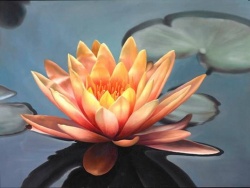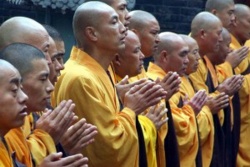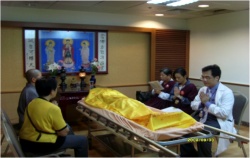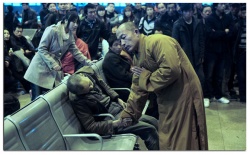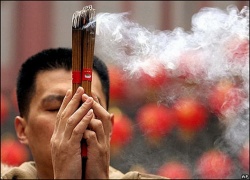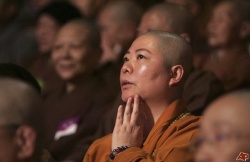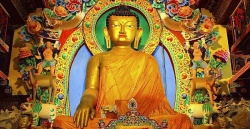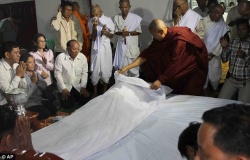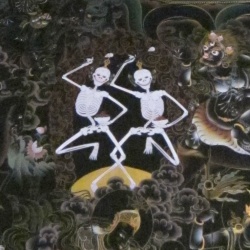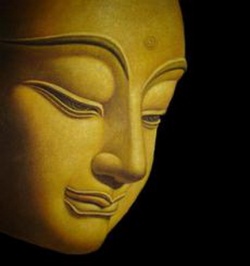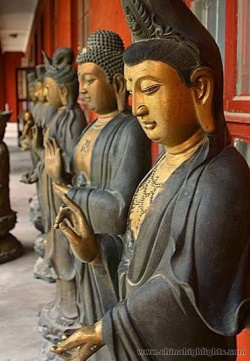Crossing the Gate of Death in Chinese Buddhist Culture
1. An Overview of Chinese Buddhist Culture
Traditionally there are ten schools of Buddhism in China and eight of them belong to Mahayana Buddhism. Four of them are practical in the sense that they possess special practices which are actually practiced by many followers. These are the Pureland School, the Tantra School, the Chan School and the Sila School. The Pureland School with its emphasis on the chanting practice has been most popular. Nowadays the meditation practices of Tibetan Tantra and those of the Southern Tradition are embraced by a growing number of Chinese Buddhists.
Upon closer examination, many Chinese Buddhists, in the sense that they are considered by others as well as by themselves to be followers of the Buddhist religion, practice a mixture of Buddhism, Taoism and Confucianism. This is evident not only from the deities they worship on the altar, and the religious or health practices they adopt, but also from their outlook and way of life. This is in fact a prominent feature of Chinese Buddhist Culture over the ages.
In the United States of America, Chinese Buddhists came from and are rooted in the traditions of Mainland China, Taiwan, and South-Eastern Asian countries. The prominent features of the present scene may be classified into Pureland practice, Tantric practice and Meditation practice.
2. The Chinese Buddhist view of dying, death and life after death
Basically the Chinese Buddhist view of dying, death and life after death follows the Buddhist teachings. It may be simply described as follows: Due to ignorance and attachment sentient beings constantly engage in self-centered activities. Consequently, by the force of such activities, called karma, they are helplessly engulfed in transmigration within the six realms of suffering. These six realms are: heavens, asuras, humans, animals, hungry ghosts, and hells. Through understanding the Buddhist teaching and realizing their significance by devoted practice, one may achieve transcendence from this cycle of transmigration. The transcendental states are classified as Sravakas, Pratyeka-buddhas, Bodhisattvas and Buddhas. One may achieve transcendental states in this or some future life.
Human life is concurrent and inseparable from two factors: consciousness and warmth. Dying is a gradual process thereby the consciousness completely separates from the body. Death occurs when the body completely loses its awareness and temperature. People who have achieved transcendental states in life are no longer subject to transmigration. However, they may choose to take rebirth in order to further their training on the Buddhist path or to help sentient beings advance on the path. People who have not achieved such transcendence may still obtain rebirth in a Buddha's Pureland through the blessing of Buddha. Upon death, very good persons go to Buddha's Pureland or heavens at once and very bad persons fall into hells immediately. For most people the consciousness will be in a limbo state for an indefinite period of no more than forty-nine days. In this state the consciousness experiences a floating sequence of scenes without the power to choose. Every seven days during this period the consciousness will experience a dying process. This period ends when the consciousness is drawn by its karma and takes rebirth in one of the six realms.
According to this view, death may be considered as a gate through which the consciousness departs from one life and begins the journey to a new life. Hence, the title of this article uses the term the Gate of Death. Occasionally people revive after having lost all vital signs and been officially pronounced dead. Hence, death is not always a one-way passage but sometimes a revolving door. The part of the body where warmth lingers till the rest of the body has become cold is also called the Gate of Death in the sense that the consciousness finally leaves the body through this spot, and its relative position on the body is believed to indicate which realm the consciousness is migrating to. In general, the higher spots indicate better realms and the lower ones indicate worse realms.
The popular Chinese belief describes one's death as follows: When the time of death comes, ox-headed and horse-headed delegates of Yen Lo, the chief justice of the ten judges in Hell, will lead one's soul across the Nai He (desperate) Bridge, which extends over the boundary of life and death, to hell. There one will be judged according to one's karma and sentenced to rebirth in one of the six realms. Before one's rebirth one will be given a Meng Po soup to drink and thereby one's memory of one's past life is obliterated. This popular belief is not formally embraced by Chinese Buddhists. Nevertheless, the rituals and festivals related to the deceased and ghosts are often based also on this popular belief.
Life is impermanent with suffering lurking, and the suffering of transmigrating in the cycle of life and death is beyond comprehension. Buddha achieved liberation from this vicious cycle and then pointed out the path toward such liberation for all sentient beings. Buddha teaches that our self-centered way of life can be unlearned, and that the root of suffering, a sense of self, can be eradicated by the wisdom insight of the conditional nature of all phenomena. Buddha teaches practices that will eventually restore one's original purity. Some of these practices aim at gaining rebirth in a Buddha's Pureland at the time of death, while others aim at achieving Enlightenment within this lifetime or in some future life. Buddhist liberation is not only transcendence beyond transmigration in the six realms of suffering, but also a perfect union of fully developed wisdom and compassion.
To a Buddhist, life is an opportunity to work for transcendence beyond transmigration, for awakening to our original purity, for full development of our innate potentials, and for compassionate service to all sentient beings. People who let their time and energies be tied down by self-centered needs and desires will not only lose such a wonderful opportunity but also be doomed to continue their suffering in transmigration.
To a Buddhist, death is a reminder of impermanence, of the preciousness of life, of the need to be diligent in Buddhist practice; it is also a teacher of complete renunciation, of no attachment, of appreciation and gratitude, and of purity beyond worldly concerns and considerations. Death is the ultimate test of one's lifelong training in Buddhist practices. Many ancient Chinese practitioners demonstrated their accomplishments through their marvelous ways of crossing the Gate of Death.
3. Rituals and Activities Related to Death in Chinese Buddhist Culture
Rituals and activities related to death are adopted by Chinese Buddhists according to their belief, the instructions they seek from Buddhist teachers, and the tradition they live in. In case of devout Buddhists, they will follow the practices they have long been used to, and the inclusion of popular non-Buddhist practices will be less. For ordinary Buddhists the rituals and activities adopted are usually the ones maintained by the professionals, and these are often mixed with practices of Taoist traditions.
The basic principle underlying the rituals and activities related to death is twofoldCpurification of bad karmas and accumulation of merits. Bad karmas may drag one down to undesirable realms, while lack of merits will prevent one from getting a good rebirth or attaining transcendence from transmigration. According to the Law of Cause and Effect worldly activities will yield only worldly results; hence, only merits imbued with the spirit of Buddhism will lead to transcendental consequences. In other words, charity done with selfish motivation may help one go to heavenly realms after death, but cannot pull one out of transmigration. Only services rendered in a selfless and compassionate way will add to the merits credited for liberation.
In general, the activities related to death may be classified into rituals of elevation and acts of merits. The merits thus generated are dedicated first to the Enlightenment of all sentient beings, and then to the well-being of the deceased. Rituals of elevation usually consists of chanting, with the accompaniment of ritual musical instruments, of sutras, mantras and holy names of Buddhas, prostrations, offering of candles, flowers, incense and all sorts of food and drink. Prayers of repentance on behalf of the deceased is also an essential part of these rituals. For this kind of occasions, the most commonly recited sutras are Amitabha Sutra, the Heart Sutra, the Diamond Sutra, and the Earth Treasure Sutra. These rituals are usually conducted by professionals who may or may not belong to the Sangha. Sometimes family members and friends also conduct, in private, chanting and prostration for the deceased. Acts of merits may include: donations to monasteries or nunneries, monks and nuns, and charities; free distribution of sutras and books on Buddhism; releasing of endangered lives to freedom; voluntary services rendered to the sick and needy in orphanages, hospitals, hospices and convalescent homes; etc.
In the United States, some areas have a large Chinese community, for example, the areas surrounding New York City, San Francisco, Los Angeles and San Jose, respectively. In these areas it is relatively easy to obtain professional as well as voluntary help on matters related to dying and death from Chinese Buddhist communities. There are Chinese monasteries, monks and nuns, and groups of lay Buddhists organized to help dying persons by chanting Amitabha near the bedside. In the New York area there is even a Buddhist pagoda for ashes. For Chinese who reside outside these areas, they often have to seek help from relatives and friends in these areas or back home in Taiwan, Hong Kong, etc. The help sought is often for some professionals to perform some rituals of elevation or to conduct some acts of merits, like the releasing of lives to freedom.
3.1 Rituals and Activities Related to Dying
To Buddhists who are keenly aware of impermanence, living is concurrent with dying. Hence, as preparation for transcendence from transmigration, they would try to accumulate as much merits as possible in daily life. Some would even renounce worldly activities completely and devote their time and energies exclusively to Buddhist practice and compassionate service. Besides the meritorious activities mentioned above, some Buddhists would pay special attention to helping people who encounter death of loved ones. They would offer to help out, especially by chanting the name of Amitabha Buddha near the dying person. In so doing they not only invoke the blessing of Buddha, provide support and serenity to the situation, but also learn for themselves how to face death in tranquility.
In Taiwan there are many voluntary service groups, usually called Help Chant Group, whose main activity is to organize shifts of chanting groups so that a dying Buddhist will be accompanied by clear and continuous chanting of Amitabha throughout the dying process. In southern California there are this kind of groups now. In Honolulu, some Buddhist friends are preparing to organize such a group. This is a wonderful Buddhist social security system for providing peaceful and transcendental finales. May Amitabha Buddha bless the spreading and growth of Help Chant Groups everywhere.
The state of mind of a dying person is considered most crucial to his transcendence or rebirth. Hence, it is emphasized in Chinese Buddhist culture that one's final thoughts should be free from worldly attachments and be directed toward Buddha, Pureland, Bodhicitta and Enlightenment. One's family, relatives and friends should withhold expressions of grief so as not to disturb the peace of mind of the dying person; they should instead help strengthen the dying person's Buddhist aspirations by kind advice and Buddhist practice. This is of course easier said than done; hence, it is most important for people to understand these crucial matters and build the habit of doing some Buddhist practices well in advance.
Chinese Buddhists would try to arrange for the dying person to stay in a peaceful and comfortable environment, preferably accompanied by the chanting of Amitabha which may be sung by people or played by audio tapes. Nowadays, one is pronounced dead by a physician when the pulse and brain waves are gone. From the Buddhist point of view, even then the person is still dying; the consciousness is still in the process of separating from the body. During this process it would be very painful if the process is disturbed by movement of the body or abrupt environmental changes. Hence, it is taught that the body should not be disturbed in anyway for at least eight additional hours, preferably until it is cold all over. During this dying process the accompanying chanting should continue.
When a Buddhist staying in a hospital is pronounced hopeless for recovery, the family members should consider bringing the patient home so that the final hours would be more comfortable. In case the person is dying in a hospital, the family members should try to obtain approval for the body to remain untouched for eight additional hours. If the dying person is in the intensive care unit, perhaps it can be arranged for the patient to be moved to an ordinary sickbed for the additional eight hours. Of all the apparatus attached to a dying patient, my view is that tubes in the mouth or nose should be removed when death is pronounced, while the rest can remain untouched. The reason is that the dying process has much to do with the movement of one's inner air and tubes in respiratory passages may create undesirable outlets.
If the family of the dying person does not approve of the practice of accompanying chanting, it can still be done at a distance because the spiritual help can reach out in full strength over any physical distance. This is not a dogmatic assertion but a truism born out by experiences of practitioners. Some would object to this practice due to the misunderstanding that chanting Amitabha at this time amounts to hurrying good-bye before actual departure. In fact, the blessing of Amitabha Buddha is not limited to welcoming sentient beings to his Pureland; his blessing can also help recovery from illness when dying is not irreversible. When one's death is imminent, all worldly endeavors to keep one alive become either futile or disturbances. During those hours the only sources of comfort and stability are one's peace of mind born from meritorious deeds, and spiritual support from others who are performing acts of merits on one's behalf. Therefore, we should begin the chanting practice or other meritorious activities for dying persons as soon as possible.
A Buddhist's immediate response to life-threatening situations depends very much on his usual training in Buddhist practice. In case of accidental death one is left alone with only one's spiritual maturity and Buddha's blessing to rely on. Hence, in order to be better prepared, one should build up a particular chanting practice so that even in case of accidental death one's last thoughts will, as if by reflex, focus toward Buddha. The best way to build up this practice is to choose a particular holy name or mantra as one's life-saver and form the habit of chanting it daily, if not constantly.
The Buddhist ideal conditions for dying are as follows: the consciousness is clear and focused, without fear, ready to depart from this world, and full of aspiration for Buddha, Pureland, Bodhicitta, and Enlightenment. Since the movement of consciousness is inseparable from that of the subtle inner air, and the sitting posture is conducive to upward movement of the inner air, it is recommended for dying when feasible. In addition, if the environment is comfortable and supportive in the direction of pure thoughts, namely, reminding and encouraging one's Buddhist aspirations, then it would be even better. These conditions are conducive to a good rebirth or transcendence from transmigration.
In contrast to the ideal conditions, dying in sleep, in unconsciousness, under the influence of drugs, in accidents, in natural calamities, or by violent means are causes of concern for the outcome of the departing consciousness. The Buddhist teaching of no killing applies to all sentient beings, including oneself and unborn babies. Sentient beings who have died of suicide or abortion are also considered to be in great need of spiritual help. Rituals of elevation and acts of merits should be performed for all these cases of death to lessen their suffering, and to reduce the chances of their haunting the living.
3.2 Rituals and Activities Related to Death
When the body of the deceased is completely cold, then it may be cleaned and dressed. If the limbs are stiff and cause difficulty in changing clothing, use hot wet towels to wrap the joints, and then those areas will become soft and flexible. If the eyes are not closed, cover them with hot wet towels, and then they may be closed by hand. Usually new clothing, new shoes, jewelry and ornaments are used to adorn the deceased. Rituals are performed and then, with family members watching and under the guidance of professionals, the corpse is sealed in a coffin. If the deceased is a married woman, someone from her maiden family should be present to witness her entering the coffin. Usually the coffin stays in the funeral house, with a small altar set up in front for displaying offerings of candles, flowers, incense, fruits, etc. The professionals will invite the soul to follow and lead it back home. In case of accidental deaths, it is customary for family members, accompanied by professionals, to go to the spot of accident to call and escort the soul home. This is usually done even when the place is far away and abroad.
In the United States the body of the deceased is usually stored in special refrigerators in the funeral house awaiting the memorial service ceremony. To present the deceased with a good appearance, sometimes the corpse is embalmed and cosmetics applied. Sometimes the corpse is cremated soon after death. Before the consciousness has left the body completely, the refrigeration, cremation and use of chemicals may cause suffering to the consciousness. The family can delay the time of sending the body to the funeral house and decline the application of chemicals.
At home, a white piece of paper with words announcing a death in the family is posted on the outside of the main entrance. Inside the house, a temporary altar is set up with the deceased's photo and lotus seat placed at its center. A lotus seat consists of a paper or wooden rectangular block with the name of the deceased written on it; it is where the consciousness is supposed to reside temporarily. The usual offerings of flowers, candles, incense, food and drink are displayed and replenished now and then. During the next forty-nine days this is the main place for rituals and for visitors to show respect. The visitors would offer incense, flowers and food to the deceased, bow to the photo, and present money or posters with words of memorial or honorary nature written on them to the family. These posters will be displayed at the memorial service to honor the deceased. Usually the posters for funerals are in white; however, when the deceased had passed eighty years of age red color may also be used to celebrate a good long life. Every seventh day after the death the professionals are invited to come and perform rituals. This is based on the Buddhist teaching that the consciousness in the limbo state would go through a dying process every seven days. Hence, it is high time to offer special help for transcendence or a good rebirth. Nowadays some people rush the process of these rituals into once every three days; this is not very considerate for the situation of the deceased; nevertheless, it is still much better than not doing it at all.
Depending on the family's affinity to particular schools or sects of Buddhism, they may employ the following special activities or rituals. Followers of Pureland school usually chant Amitabha, Guan Yin Pu Sa, Pureland sutras, and the Mantra of Rebirth in the Pureland. Sheets of paper with this mantra printed on them are burned as offering of blessing to the deceased. Followers of Tantra usually use Dharani sheet, a piece of yellow silk with many mantras printed on it, to cover the body of the deceased. Some would offer Vajra sand, which is obtained from some holy place and blessed by some Guru, in small containers to be worn by the corpse. Some would ask Lamas or practitioners to perform PowaCa tantric practice to transfer the consciousness of the deceased to the Pureland, fire sacrifices to Amitabha Buddha, or offer precious vases to the protectors asking for their escort. Some would follow the Tibetan Book of the Dead, which has several English renditions and at least one Chinese version, and try to give guidance to the deceased day by day.
According to the oral teaching of my late Guru, Yogi C. M. Chen, the Buddhas described in the Tibetan Book of the Dead cannot be seen by the consciousness of people who had not been initiated into this teaching. People often mistakenly assume that tantric experiences are automatic as long as the texts are obtained and followed to some extent. I would like to add the observation that even for initiated beings, their experiences will not be exactly as described in the textbook. A textbook offers a model, while each individual's particular situation and propensity will certainly add variations into the final result. Nevertheless, unless one has the supernatural ability to observe the situation of the deceased, one should simply follow the textbook and pray that these Buddhas will help where we cannot.
The date for memorial service, or farewell ceremony, is usually chosen according to Chinese lunar calendar. It often involves calculations by experts to avoid conflict with the Eight-Words, the lunar birth hour and date, of the family members and be favorable for funeral proceedings. The memorial service is usually held at the funeral house or some public place, and involves basically the same offerings and rituals, but on a much grandeur scale. It is customary for all relatives and friends to gather to show respect and listen to eulogies. The immediate family members wear traditional clothing of mourning and often prostrate to the guests in return for their bowing to the deceased. Traditionally, the family members are supposed to wail continuously, consequently sometimes there are professional mourners hired to perform this difficult task. Nowadays this kind of unnatural act is no longer popular and the traditional wears of mourning are often replaced by black robes.
In all rituals related to death, various kinds of paper currency are burned for different kinds of deities. These paper currencies are either paper with gold or silver foil glued onto it, with auspicious signs and words printed on the gold foil, with images of auspicious deities printed on it, or so-called hell-bank notes. They are offerings, respectively, to the heavenly deities, the earth deities, the delegates of Yen Lo, and pocket money for the deceased. At the conclusion of the memorial service the professional helpers will burn, behind the scene, paper models of house, T.V., car, and many other utensils for the deceased. Some Buddhist teachers object to this kind of activities. I know of cases where the deceased appeared in a dream to some relative, asking for this kind of offering. I was once instructed in a dream by the local mountain god as to which kind of paper currency they preferred. It seems to me that, unless we know for sure that the deceased does not need these, it is better to make these offerings.
After the memorial service, the coffin, accompanied by family members, relatives and friends, will head for the burial ground. The burial ground is sometimes chosen by a geomancy specialist to enhance the chance of prosperity for the posterity. After eight or ten years the coffin will be unearthed, and then the bones will be gathered in an urn and buried for good. In case of cremation, which is usually the case for members of the Sangha, people look into the ashes for sariras as signs of achievement in concentration meditation. If sariras are found, they are usually honored on the altar and prostrated to for blessing. The cremated remains are gathered in a container, and then either buried or stored in a pagoda for ashes, which are maintained by cemeteries or monasteries. Some Buddhists leave will to have their ashes scattered into a river or ocean so as to develop karmic connection with beings that will feed on these ashes. At home or in a monastery, a lotus seat will be established on the altar to represent the deceased. This is also the way to honor a deceased whose remains cannot be restored to the family. (By the way, one way to appease a haunting ghost is to establish for him a lotus seat in a monastery because the ghost will then have easy access to offerings and Buddhist teachings.) The family will continue to make offerings to the deceased, at least on the first and fifteenth of every lunar month. After one to three years the lotus seat will be removed and considered merged into the lotus seat for all ancestors. This ancestral lotus seat stays on the altar for all posterity.
4. Activities Related to Death and Ancestors in General
Daily offering of water, incense and candles to Buddha, holy beings and ancestors is a common practice in Chinese Buddhist families. On all important occasions and festivals, making offerings to Buddha, holy beings and ancestors is always a crucial part of the festive activities.
There are rituals of alms giving to the hungry ghosts who have a huge belly, a needle-like neck, and a fiery mouth, and are thus rendered into constant starvation. These rituals are called Fang Yan Kou meaning alms giving to fiery mouths. This is also often practiced in conjunction with rituals of elevation for the deceased. Some Buddhists practice alms giving to the hungry ghosts every night, and the rituals followed varies from very elaborate to very simple. Once a Buddhist begins this practice, he is expected to continue it on a daily basis without fail. This is a very good practice for training in compassionate service. Every evening I gather the rice which has been offered to Buddha during the day, and pour it into a particular plate which is placed at a certain place in the house, for the ghosts. The next morning I scatter the rice on the lawn in my backyard for the birds.
Early in the lunar March there is one day called Qing Ming Festival when virtually every family visits the tombs of their ancestors. They would clean up the place, make offerings and do prostrations. This is a good custom to remind people of their roots, and for people to express their remembrance of and gratitude to the forefathers.
According to popular belief, the gate between the world of the living and that of the ghosts opens on the first of the lunar July, and it remains open for the whole lunar month. Hence, during that month it is easy for the ghosts to visit us. On the fifteenth of the lunar July, every household prepares elaborate offerings to all ghosts so as to appease them. Buddha taught that on this day one may make wondrous food offering to Buddha and Sangha, and the merits accrued may save one's parents, of this or one of the last six lives, from suffering in transmigration. Therefore, this is also the day of making offerings to Buddha and Sangha in remembrance of one's parents.
There are mediums who can help the living communicate with the deceased. In order to ease the pain of grieving, some people would seek help from such mediums. I have heard of plausible cases of mediums. However, successful communication through mediums does not mean transcendence over suffering, while attachment for such communication is certainly a cause for suffering. Hence, this kind of communication cannot be of much help. According to the Buddhist teaching, one should let go of such attachments and concentrate one's energies on performing Buddhist practices and acts of merits, and then dedicate the merits to all sentient beings, including our dear ones. This is a much better way to help ease the grief of separation.
5. Buddhist Accomplishments as Revealed through Marvelous Manners of Death
The main concern of this article is about the common practices of Chinese Buddhist Culture. Therefore, the presentation so far is only about ordinary Buddhists' death. Nevertheless, one should also examine marvelous cases of Buddhist death which have inspired reverence and faith in the Buddhist teachings.
The history of the Pureland school is replete with records of Buddhists who were informed in advance the time of their death by heavenly voices or holy beings appearing in meditation or a dream. Upon death some were welcomed by the appearance of Amitabha Buddha and Bodhisattvas, and sometimes these miraculous appearances were witnessed by the attendants. Some saw bright light coming from the Western sky, some smelt extraordinary fragrance, and some heard heavenly music. Even nowadays we still learn of such examples from time to time. When my late Guru, Yogi Chen, entered Nirvana, two persons nearby heard heavenly music playing the Five-variation Chanting of Amitabha.
In the history of the Chan school, many passed away in sitting meditation, some deliberately died during a walk, some while standing, and one, in order to be unique, even died standing on his head. When the time of departure is near, some Chan monks sat or stood on a pile of woods and then started the fire themselves, and they remained still and peaceful throughout the cremation. Some entered Nirvana, and then came back to life to comfort the disciples for a week, and then entered Nirvana again. They simply went through the Gate of Death at will and with ease beyond imagination.
Some monks prepared their death in special ways and left a Vajra body, namely a body that does not decay. There have been two such bodies in Taiwan in the past forty years. Both were honored with gold foil covering the whole body. In mainland China a famous example is the Vajra body of Hui Neng, the Sixth patriarch of the Chan school. Another famous example is the Vajra body of a holy monk on Jiu Hua Mountain. During the infamous "cultural revolution" it was hidden by monks in a cave underground. For nearly a decade before its reappearance, due to the collapse of the cave coverings, it had been soaked in water and buried under heavy rocks and soil. Nevertheless, it remains undamaged. The hands of this Vajra body turned into a covering mudra from its original meditation mudra during a big fire when the monks refused to leave it behind and run for safety. The fire stopped just short of burning to the building where it was displayed. This movement of the hands occurred after hundreds of years had passed.
All these examples show that Buddhist teachings are based on reality beyond ordinary reach. Buddhist teachings do not encourage attachment to or wanton exhibition of supernatural accomplishments. Hence, one should not hover this kind of special achievements as a goal in itself. The supernatural powers are innate to all of us. Through training in Buddhist practices they may have a chance to develop naturally and fully. Nevertheless, they are natural by-products only, and the Buddhist goal should be liberation from transmigration, and wise and compassionate service to all sentient beings.
Questions and Answers:
Q1: AIDS patients, knowing they will die in a few years, are struggling to stay alive. What can a Chinese Buddhist offer to such persons who are not Buddhists by training or tradition?
A: Impermanence applies to all, hence a person free from AIDS will not necessarily live longer than an AIDS patient. Knowing this may reduce the sense of being particularly in a crisis situation for an AIDS patient.
From the spiritual point of view, AIDS patients are actually in a better position than most people because they are fully aware of the coming of death and hence may prepare for it. Many people realize the closeness of death only at the very last moment of their lives; how could they prepare for a peaceful departure?
Since death is inevitable, the key point is to make the best use of the rest of our lives and this applies to all of us. Chanting a mantra or the name of a Buddha is a basic practice that may help calm our minds. Engaging in simple and yet meaningful activities may divert our introspection and preoccupation with ourselves and help us to go on living with an open-minded attitude.
AIDS patients may serve as personal examples of Impermanence, reminding others to become aware of impermanence and of their own good fortune, thereby helping others to become free from preoccupation with worldly concerns.
Q2: Please expand on what we can learn from the dead to improve our lives, prepare for a peaceful ending, and prepare for a better next life.
A: Buddhist emphasis on being aware of impermanence is neither pessimism nor obsession with death. Being aware of impermanence, in particular, of death, may help us reflect on our lives as a whole, and cause us to search for its significance.
Realizing that in the end we will have to give up everything that we have held onto or worried about, what really counts in the end becomes clear what are our regrets and what are our comforts. Whatever we have done wrong and caused others to suffer will prey on our conscience, and whatever service and care we have provided for others will result in peace of mind and joy. Thus, we should set the priorities of our lives in this light how to increase comforts and reduce regrets for the ultimate accounting of our lives.
Being aware of the universality of impermanence will increase our appreciation of others' kindness and services. When someone is helping us we are taking up the most precious moment of his life, this moment when he is surely alive (the next moment may never come), and he is putting us on top of all his priorities.
Peace of mind is essential and basic to a happy life. Buddhist practices and compassionate services may help cultivate our basic sense of well-being. Only our spiritual strength and tranquility may help us survive the storms of life. In times of stress or crisis, spiritual strength may help others in inconceivable ways. I strongly recommend that we adopt the habit of daily Buddhist practice so as to cultivate our inner strength and peace.
Q3. Nonexistence of a self is a fundamental teaching of Buddhism. In the light of this teaching, what is that which goes through transmigration?
A: Nonexistence of a self means self is a concept without justifiable referent. When this fact is clearly understood, the reality, which is free from the duality of subject/object distinction, becomes apparent. In this state of oneness-of-all any identification with a particular is impossible. Hence, there is no I, no my, and no mine. Needless to say that, in this oneness-of-all, there is none who is transmigrating.
However, nonexistence of a self does not imply nonexistence of things as they are. In our phenomenal experiences we do notice men and women, flowers, birds, clouds, winds, etc. Furthermore, to facilitate transactions in daily lives we have found it convenient to distinguish and label people and objects. Problems arise when we become limited by conceptual thinking and lose touch with the reality of oneness-of-all. We become self-centered and put our tiny selves above all else. As we experience ups and downs in life, our preoccupation with our selves dictates the turbulent course of our inner life.
When one is not free from the dominance of the concept of one's self, one's experiences of living, dying and rebirth constitute transmigration. To avoid the connotation of a self, Buddhists use consciousness (the eighth consciousness, to be technically correct) to designate that which experiences the transmigration. In my article I use the common term soul when the context is about non-Buddhist beliefs or practices. Nonexistence of a self does not mean there is no cycle of life, death and rebirth, it simply means the flux of phenomena can be divided into observer/observed only artificially, but not without distortions.
Q4: What is your view on organ donation? If the deceased is still sensitive to pain, would not the surgical procedure be cruel to the dying person? If the organ donor is anesthetized to reduce the pain, would that constitute a hindrance to a good rebirth?
A: The Bodhisattva ideal of Mahayana Buddhism is exemplified through many stories of personal sacrifices for the well-being of others. In particular, we are taught that many Bodhisattvas would freely give their organs upon request. The Buddhist teaching on dying emphasizes no touching or moving of the dying body so as to avoid causing pain and anguish, and consequently creating hindrance to a good rebirth. As ordinary Buddhists, what shall we do to donate or not to donate our organs upon death?
According to Buddhist teaching, surgical procedure done before the body is naturally completely cold will inflict pain and suffering to the dying person. Usually this will induce hindrance to a good rebirth. Nevertheless, when the dying person, out of Bodhicitta to help others in a selfless way, has made a will to donate his organs, he will be protected by Buddhas and become free from transmigration through such a compassionate act of selfless offering. The pain he endures will nullify all his bad karmas.
Loss of consciousness during the dying process is usually cause for falling into undesirable realms. Nevertheless, a Bodhisattva will certainly gain rebirth in Buddha's Pureland or a good Buddhist family. Hence, the application of anesthesia in such cases of organ donor is advisable.
Q5: Can chanting reproduced through machine be effective?
A: Some people think that only chanting performed in person by practitioners would carry the mysterious force, hence, they have little regard for playback from tape recorders, not to mention chanting synthesized by integrated circuits. Of course, when chanting is done in person by a practitioner, it is usually easier for those present to sense the mysterious force. Nevertheless, according to the Buddhist teaching of the equality of all things (Dharma) as inseparable parts of the Dharmakaya, chanting performed by any means can be equally effective. In Buddhism it is taught that all sounds constitute the speech of the Buddha.
Of course, it is nice to have people gather around a dying person to help maintain the chanting. The presence of people chanting would yield a strong sense of support for the dying person. However, when people are not present, the use of a machine should be considered as equally effective. All chanting are fundamentally the outpour of great compassion from the Dharmakaya, whether it is human voice or machine synthesized matters naught in the original purity of Limitless-Oneness.
Source
Dr. Yutang Lin
(Chenian Memorial Series No. 16)
June 17, 1995
Tan Wah Temple, Honolulu, Hawaii
a presentation in Understanding Death in Chinese Buddhist Culture LIVING AND DYING IN BUDDHIST CULTURES
a program presented by SHAPS Buddhist Studies Program and Summer Session University of Hawaii at Manoa
Acknowledgement
Thanks to Ann Klein
for improving the English of this work.
yogichen.org
